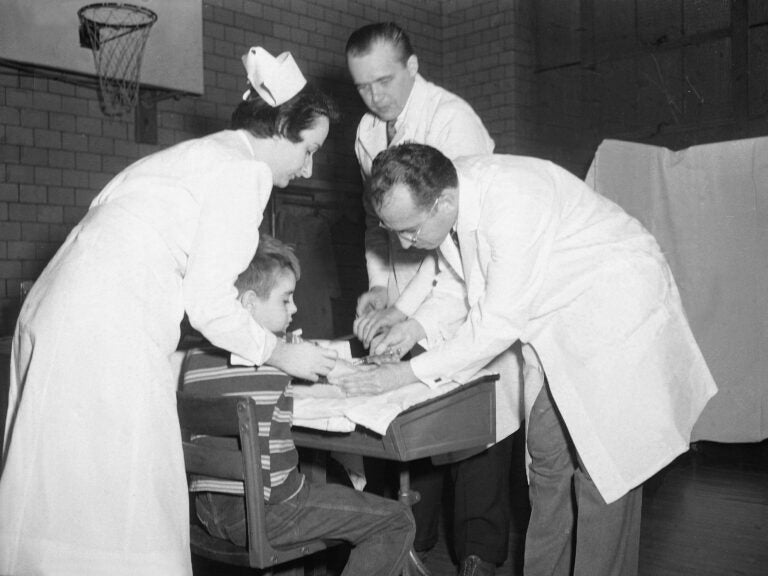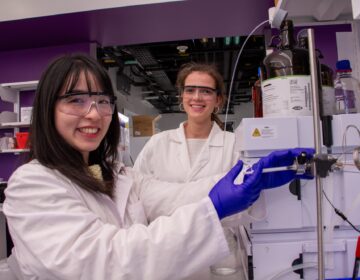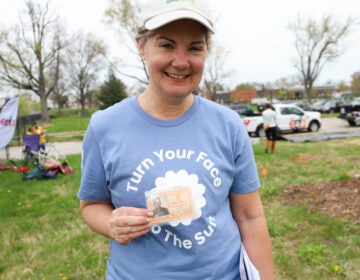The race for a polio vaccine differed from the quest to prevent coronavirus

Dr. Jonas Salk, the scientist who created the polio vaccine, administers an injection to an unidentified boy at Arsenal Elementary School in Pittsburgh, Pa., in 1954. (AP)
COVID-19 isn’t the first health crisis the United States has faced that experts say a vaccine will be needed to resolve: In the 1950s, people lived in fear their children might be stricken with infantile paralysis, better known as polio — and they were eager for scientists to find a solution.
“There was a lot of anxiety,” says New York University medical historian David Oshinsky, author of Polio, An American Story.
The polio experience differed from today’s COVID-19 in one important respect: by the 1950s, polio — a disabling and potentially deadly disease — was a familiar threat. Even former President Franklin D. Roosevelt had been stricken with the disease.
“It has been around for quite a while,” Oshinsky says. “Certainly by the end of World War II, it had become a summer plague just sort of hitting the United States again and again and again at the same time of year.”
Then, as now, there was no effective treatment for polio, so a vaccine seemed the only way out. But even so, Oshinsky says the government played very little role in coming up with a vaccine for polio.
“There was no federal research being done at this time,” he says. “[The National Institutes of Health] was this teeny little organization, so it was basically up to a private charity to deal with this.”
That charity was the National Foundation for Infantile Paralysis, today known as the March of Dimes.
Competing candidates
There were several teams working on a vaccine…but the Foundation focused on two. One was a more traditional vaccine, being developed by a well-regarded virologist named Albert Sabin. The Sabin vaccine consisted of a weakened form of the polio virus that stimulated an immune response, but did not cause the disease.
The other was a less studied approach using a virus killed with formaldehyde and then packaged into a vaccine. Despite many naysayers, the inventor of this approach was convinced it would work. His name was Jonas Salk.
Both camps received a lot of money from the Foundation, says Oshinsky, “but it was clear that the Salk camp could produce a quicker vaccine.”
In the spring of 1954, a massive study of the Salk vaccine kicked off. At the time, confidence in the National Foundation for Infantile Paralysis was high, as was fear of the polio virus, and millions of children took part in the trial.
“I don’t know if we could even do the Salk polio vaccine trial today because I don’t know if there’s an organization that has the same level of trust,” says Marcia Meldrum, a social scientist at UCLA.
Salk didn’t think there needed to be a control group that received a placebo vaccine because “he believe that his vaccine worked,” says Oshinsky.
But Thomas Francis, a well-known virologist tasked with overseeing the trial, insisted that one was necessary to verify the results.
The announcement of results came the following year. “Safe, effective, and potent,” is how Francis characterized the vaccine on April 12, 1955.
“The Public Health Service immediately licensed five different pharmaceutical firms to produce it,” says Meldrum. But there was a problem.
“One of them did not do a good job,” she says.
Vaccine problems
Mysteriously, some children developed symptoms of polio after receiving the vaccine.
It turned out that the vaccine made by Cutter Laboratories was responsible. The company’s manufacturing process did not fully kill the virus they used to make their vaccine. As a result, hundreds of children who got the Cutter vaccine got polio, and some died.
The debacle with the Cutter laboratories shattered public trust and the government suspended all vaccinations while it investigated.
Ultimately the vaccines manufactured by other companies were declared safe, and people started getting vaccinated again.
Oshinsky, the historian, says despite the setback, the story of the Salk vaccine is one of the great success stories of American medical research, and there are lessons for the COVID-19 vaccine effort.
“We want a vaccine as quickly as possible,” he says. “But in the end, Cutter [vaccine experience] also tells you’ve got to be cautious. You can’t do it too quickly.”
9(MDAzMzI1ODY3MDEyMzkzOTE3NjIxNDg3MQ001))


![CoronavirusPandemic_1024x512[1]](https://whyy.org/wp-content/uploads/2020/03/CoronavirusPandemic_1024x5121-300x150.jpg)


